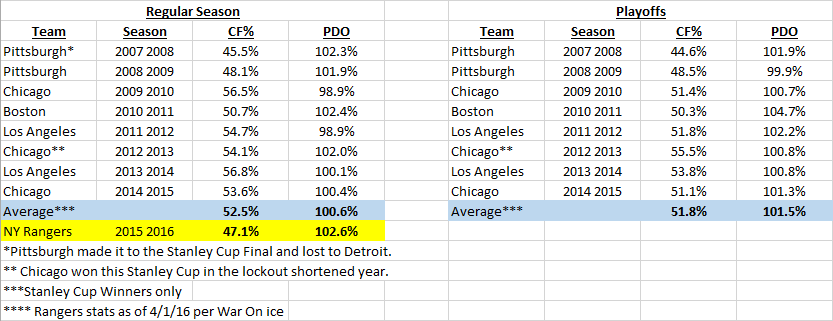The Rangers Best Shot At A Stanley Cup Is Mimicking The ... Penguins?
The New York Rangers might want to copy a division rival's road to the Stanley Cup.
The New York Rangers are (most likely) a playoff bound team thanks to a remarkable run of luck, an elite goaltender who put on a historic show this year and a team that's been good enough to, at times, overcome their poor advanced metrics and string together some wins.
The Rangers have struggled of late, going 5-4-3 in their last 12, and seem to be stumbling into the playoffs. As of this writing they're slated to play the Pittsburgh Penguins, but that's not set in stone. Another loss or two could see the Rangers fall to the first wild card spot to take on the Florida Panthers -- which might not actually be that bad of a thing.
Ironically enough, the very scary Penguins are the organization the Rangers should be hoping to mimic in the playoffs this year. Not this Penguins team, but their past teams that went to the Stanley Cup two years in a row, walking away with Lord Stanley's Cup in 2008-2009.
The below is a chart I put together showing the last seven Stanley Cup winners, their corsi for and their PDO both in the regular season and then in the playoffs. Please note the notations below: Mainly that I included the Penguins team from 2007-2008 that lost to Detroit in the Stanley Cup Final before beating them the next year.
A few housekeeping notes on PDO -- since I'll assume corsi is understood to be a shot differential percentage:
PDO is the measurement of a team's on-ice shooting percentage added to their on-ice save percentage at even strength. A 100% PDO is considered average while anything below or above is unlucky or lucky respectively. The deviation of, say, three points is relatively substantial. A team with a 103% PDO is incredibly lucky while a team with a 97% PDO is very unlucky.
Notice any trends? Mainly that, you know, all the Stanley Cup winning teams (again, minus Pittsburgh) all have an above-50% corsi. Do you also notice how that trend continues in the playoffs? PDO takes a much bigger jump because of the smaller sample size at times, but in most cases it's also pretty consistent.
The Penguins, in the year they won the Cup, leveraged a relatively consistent power play (converted at a 20.6% clip over the course of the playoffs) and penalty kill (83.3%) to make their way to a Stanley Cup parade. That helped offset their poor possession metrics, although they also saw their PDO stay average (which is harder than you think with such small sample sizes).
The Rangers stats (as of 4/1) are below the averages in yellow. Notice how their corsi is below the Penguins team that won the whole thing, while their PDO is quite a bit higher.
This is going to have to be the strategy the current New York Rangers take in the playoffs. With a less than stellar defense and a whole team that isn't really capable of holding the puck for consistent stretches, the Rangers are not going to be able to keep the puck out of their own net. That means the offense is going to have to go on a massive PDO binge (i.e: a high shooting percentage) to keep the team afloat.
Henrik Lundqvist will act as the great equalizer as much as he can, but as last week's losses to the Hurricanes/Sabres proved he can't do it all. The Rangers offense will have to work with him to help give the defense a big enough lead to hold onto.
You know "The Stat" that the media shoved down our throats? The one that supposedly proved that this team and its defense were the best in the league. You know, the thing that I said wasn't true back in November. That's dead and buried. These Rangers can't close out games anymore, and it's not because "they're slumping" but because the defense isn't good enough. Anyone who claims they use only the eye test and can't see that is proof that the eye test alone doesn't work.
The Penguins example above is quite clear the exception rather than the rule, but it does prove that it's possible for a poor possession team to both make and win the Stanley Cup. The Rangers team that lost to Los Angeles in 2014 sported a 52.4% corsi and 99.7% PDO. That's a very far cry from where the Rangers are right now. And it's fitting that the big possession drives from 2014 on defense (mainly Anton Stralman) aren't with the team anymore.
The probability of the Rangers making such a PDO-heavy run isn't very high. The team seems to (at least on some nights) do the right thing by burying Dan Girardi and Marc Staal as much as possible, but Alain Vigneault counters this by continuing to play Tanner Glass in critical minutes where the Rangers need a goal. It's a give and take strategy that hurts the Rangers no matter how it occurs.
The Kevin Hayes/Oscar Lindberg/Dylan McIlrath situation doesn't help, either. And I don't bring this up to continue to beat a dead horse but instead to truly nail the coffin shut that this will not change for the playoffs, and as is such the Rangers really will need to get lucky to do any damage at all.
If the Rangers are to expect greatness this year -- and by all indications they must be since they went all in on Eric Staal -- then they did so with blinders over their eyes. They failed to see the biggest problems on the team (or perhaps ignored them) and drove the ship forward anyway; adding to something that didn't need the help and leaving alone the problem that's sinking this team.
With all of that being said, the Rangers do have the forward group to make something like this happen. Not only is J.T. Miller, Chris Kreider and Hayes coming into their own, Derek Stepan has become an offensive beast again and E. Staal will help split the offensive output from guys like Rick Nash, Mats Zuccarello and Derick Brassard. The Rangers can also expect a healthy amount of offense from Keith Yandle and some extra punches from guys like Viktor Stalberg and Jesper Fast.
The Rangers can pull this rabbit out of their hats, but they might have to mimic a divisional rival to do it.



